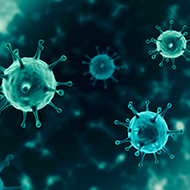
Study indicates how the virus could have adapted from bats to humans.
Researchers at The Pirbright Institute have revealed new insights into how the virus that causes COVID-19 could have adapted from bats to humans.
Their study, published in the journal PLOS Biology, identifies key differences in severe acute respiratory syndrome coronavirus 2 (SARS-CoV-2) that could be responsible for the jump from bats to humans, as well as other animals it could infect.
Dr Dalan Bailey, head of the Viral Glycoproteins Group at Pirbright, said: “Uncovering the common traits that allow viruses to jump between animals and humans helps us to identify potential reservoirs of disease and forewarn us of future threats.
“Using molecular techniques to study coronavirus spike proteins in isolation, without ever needing to work with the SARS-CoV-2 virus, has enabled us to take an in-depth look at how genetic differences in coronavirus spike proteins and animal ACE2 receptors influence which animals the virus may be able to infect.”
Comparing genomes
The origin of the COVID-19 outbreak remains unclear because no immediately related coronaviruses have been identified in animals. The bat coronavirus, RaTG13, is the closet known relative, with a 96 per cent similarity to the SARS-CoV-2 genome.
In the study, researchers compared the genomes of both viruses, identifying several regions that differed between their spike proteins - those which the virus uses to bind to the ACE2 surface receptors of cells to gain entry.
Using a method that does not involve live virus, the scientists swapped these regions to examine how well the resulting spike proteins bound to human ACE2 receptors.
They found that SARS-CoV-2 spikes containing RaTG13 regions were unable to bind to human ACE2 receptors effectively. Conversely, the RaTG13 spikes containing SARS-CoV-2 regions could bind more efficiently to human receptors, although not to the same level as the unedited SARS-CoV-2 spike protein.
This finding could indicate that similar changes in the SARS-CoV-2 spike protein occurred historically, which may have played a key role in allowing the virus to jump the species barrier, the researchers said.
Future threats
The scientists also noted that these genetic adaptions were similar to those made by severe acute respiratory syndrome coronavirus (SARS-CoV) when it adapted from bats to infect humans, suggesting there may be a common mechanism by which this family of viruses mutates.
With this knowledge, researchers may in future be able to identify viruses circulating in animals that could adapt to infect humans and pose a pandemic threat.
Other animals
Finally, the team investigated whether the SARS-CoV-2 spike protein could bind to the ACE2 receptors of 22 different animals. They found that bat and bird receptors made the weakest interactions with SARS-CoV-2, giving weight to the evidence that SARS-CoV-2 likely adapted its spike protein when it jumped from bats into people.
Dogs, cats and cattle had the strongest interactors with the SARS-CoV-2 spike protein, suggesting that efficient entry into cells could mean that infection may establish easier in these animals.



 The BSAVA has opened submissions for the BSAVA Clinical Research Abstracts 2026.
The BSAVA has opened submissions for the BSAVA Clinical Research Abstracts 2026.